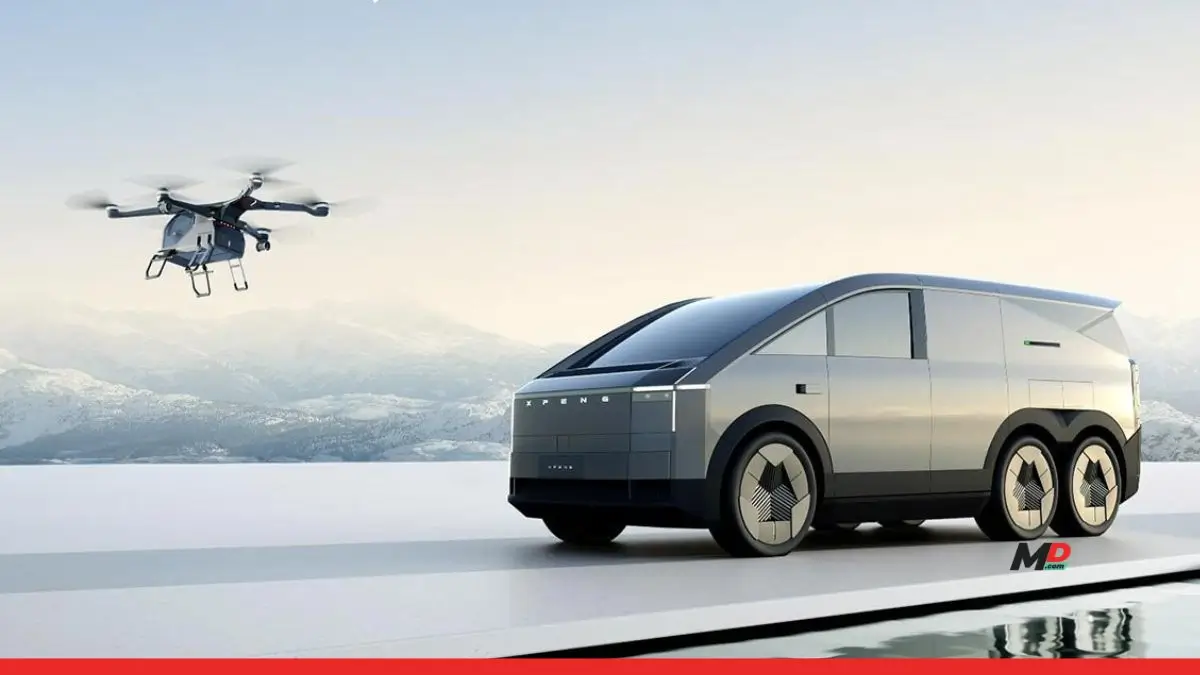Technology
Chinese EV Maker Xpeng Could Release Modular Flying Car by 2026
Published
1 year agoon

Ladies and gentlemen, fasten your seatbelts and prepare for takeoff. The future of transportation has arrived, and it’s got a distinctly Chinese flavour. Xpeng, a Chinese EV maker, has just unveiled a flying car that’s about to turn what was once only in the realm of science fiction into science fact.
In a scene straight out of the Jetsons, Xpeng showcased its latest creation at a Chinese airshow, leaving spectators with their jaws on the ground and their imaginations soaring through the stratosphere. Dubbed the “Land Aircraft Carrier” (because apparently “Car That Goes Vroom and Zoom” was already taken), this marvel of engineering is set to redefine our understanding of rush hour traffic.
Stuck in urban gridlock, vehicles such as these could leave the sea of honking horns and road rage far below. But before you start planning your aerial shortcuts to work, let’s dive into the nitty-gritty of this airborne automobile.
The Birth of a Sky-High Dream
Remember those crayon drawings you made as a kid, where cars had wings and rockets strapped to them? Well, it seems the engineers at Xpeng never quite outgrew that phase. But instead of just doodling, they decided to turn those childhood fantasies into cold, hard reality.
The journey from concept to creation wasn’t all smooth sailing – or should we say, smooth flying. It took years of research, development, and probably more than a few raised eyebrows from investors. But Xpeng persevered, fueled by a cocktail of ambition, innovation, and what we can only assume was an unhealthy obsession with “Back to the Future Part II.”
The Xpeng Philosophy: Why Stop at Electric?
Xpeng has already made a name for itself in the electric vehicle market, proving that it’s not afraid to challenge the status quo. But apparently, conquering the roads wasn’t enough for these overachievers. They looked at the congested highways and thought, “You know what? Let’s take this party upstairs.”
This audacious leap into aviation technology isn’t just about creating a cool toy for billionaires (although let’s be honest, that’s definitely part of it). It’s about reimagining transportation in a world where urban spaces are becoming increasingly crowded. It’s about dreaming big and then building those dreams out of carbon fiber and electric motors.
The “Land Aircraft Carrier”: More Than Just a Fancy Name
Now, let’s talk about the star of the show – the “Land Aircraft Carrier.” This clever modular design that’s part car, part aircraft, and all awesome. The vehicle consists of two main components:
- The “mothership” ground vehicle: This is your everyday, run-of-the-mill electric car. Well, as run-of-the-mill as a cutting-edge EV can be.
- The detachable flying module: This is where the magic happens. It’s the part that turns your commute into a scene from a sci-fi blockbuster.
How It Works (or How We Think It Works)
While Xpeng has been a bit coy about the exact mechanics, we can make some educated guesses. The ground vehicle likely serves as the base and power source, while the flying module provides the lift and propulsion needed for aerial travel.
When you’re ready to take to the skies, the flying module presumably attaches to the car, transforming it into a vehicle that would make even James Bond jealous. It’s like Transformers, but instead of turning into a robot, your car turns into… well, a flying car.
The Tech Behind the Takeoff
Xpeng’s expertise in electric propulsion systems is the beating heart of this flying wonder. By leveraging their knowledge of EVs, they’ve created an eco-friendly aerial vehicle that won’t leave a trail of fossil fuel tears in its wake.
The aerodynamics of the vehicle are probably complex enough to make a NASA engineer’s head spin. It needs to be sleek enough to cut through the air efficiently, yet stable enough to not send its passengers on an impromptu rollercoaster ride with every gust of wind.
Safety First, Gravity Second
Of course, when you’re dealing with a vehicle that defies the laws of gravity, safety becomes paramount. Xpeng has likely packed this flying car with more sensors, fail-safes, and emergency systems than you can shake a stick at.
We’re talking multiple redundant systems, advanced AI-powered navigation, and probably a “Please Don’t Crash” button for good measure. After all, when your product is designed to zoom through the air with precious human cargo, you can’t exactly cut corners on the safety features.
The Road (and Sky) to 2026: Xpeng’s Ambitious Timeline
Hold onto your hats, folks, because Xpeng isn’t content with just showing off a fancy prototype. They’re aiming to start shipping these bad boys to the public by 2026. That’s right, in just a few short years, you could be trading in your boring old ground-bound vehicle for something straight out of “Blade Runner.”
This timeline is ambitious, to say the least. It’s not just about perfecting the technology; it’s about navigating a labyrinth of regulations, safety standards, and public acceptance. But if anyone can pull it off, it’s the mad scientists at Xpeng who thought, “Hey, let’s stick wings on a car and see what happens.”
China’s Technological Leap: More Than Just Flying Cars
Xpeng’s flying car is just one piece of a much larger puzzle. China has been making significant strides in various advanced technology sectors, from artificial intelligence to quantum computing. This aerial innovation is another feather in the cap of a nation determined to position itself at the forefront of technological advancement.
We’ve already seen China showcase some pretty impressive (and slightly terrifying) tech, like rifle-toting robots. Now, with flying cars on the horizon, it’s clear that the country is committed to pushing the boundaries of what’s possible. It’s like they’re speedrunning the future, and the rest of the world is still trying to figure out how to make printers work consistently.
The Global Race To Dominate the Skies
Xpeng isn’t the only player in the flying car game. Companies and countries around the world are working on their own versions of aerial vehicles. It’s like the space race of the 1960s, but instead of aiming for the moon, we’re aiming for… well, about 500 feet above ground level.
If China, through companies like Xpeng, manages to take the lead in this technology, it could have far-reaching implications. From economic benefits to geopolitical advantages, being first in the flying car market could be a game-changer. It’s not just about transportation; it’s about who gets to shape the future of global mobility.
The introduction of flying cars won’t just change how we travel; it’ll change how we think about space itself. Our concept of personal space and privacy might need some serious recalibration when your neighbor’s car could potentially hover outside your 10th-floor window.
The Sky’s the Limit (Literally)
As we stand on the precipice of this aerial revolution, it’s clear that Xpeng’s modular flying car is more than just a cool gadget. It’s a harbinger of a future where the boundaries between ground and sky, civilian and military, and science fiction and reality are increasingly blurred.
While the challenges ahead are numerous and complex, the potential benefits are equally staggering. From revolutionizing urban transportation to reshaping our very concept of travel, flying cars could be the key to unlocking a new dimension of human mobility.
So, as we eagerly (or anxiously) await the day when we can trade in our earthbound jalopies for these high-flying marvels, one thing is certain: the future of transportation is looking up – way up. Just remember to wave to the poor souls stuck in ground traffic as you zoom by overhead.
You may like
-


The Future of Air: How 2026 Could Transform India’s Urban Breathability
-


Building a BRIDGE: The NTT Global Data Centers way
-


3 movies that make for the perfect cinematic countdown to NYE
-


Indian economy officially becomes fourth-largest in the world, but are we really rich?
-


Shri Dipankar Dutta, Deputy General Manager, National Insurance Company Limited
-


Sachin Seth, Chairman CRIF High Mark and Regional MD, CRIF India & South Asia


